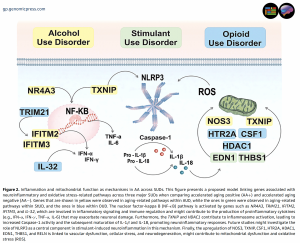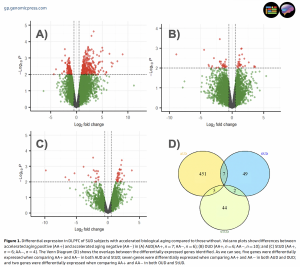
Substance use accelerates brain aging through distinct molecular pathways, groundbreaking study reveals
New research from UTHealth Houston reveals that substance use disorders accelerate biological aging in the brain through substance-specific molecular pathways.
HOUSTON, TX, UNITED STATES, April 29, 2025 /EINPresswire.com/ -- In a comprehensive Genomic Psychiatry reseatch article, researchers from UTHealth Houston have uncovered crucial evidence that substance use disorders (SUDs) accelerate biological aging in the brain through distinct molecular mechanisms. The groundbreaking study, published today in Genomic Psychiatry, examines how different substances, such as alcohol, opioids, and stimulants, affect the brain's aging process at the molecular level, potentially explaining why individuals with SUDs often experience early-onset age-related diseases. Accompanying the research article is an insightful editorial titled "The forgotten clockwork of the brain: Untangling accelerated aging in substance use disorders," authored by Dr. Julio Licinio, Editor-in-Chief of Genomic Psychiatry.
Revolutionary Study Design and Methodology
The research team, led by Drs. Bruno Kluwe-Schiavon, Gabriel Fries, and Consuelo Walss-Bass, analyzed brain tissue from 58 donors with SUDs to assess differential aging patterns using specialized epigenetic clocks designed specifically for brain tissues. Unlike previous studies that relied on more general epigenetic aging markers, this investigation employed brain-specific tools (DNAmClockCortical, CerebralCortexClockcommon, and PCBrainAge) to provide a more accurate assessment of neural aging.
"Our study is the first to investigate brain accelerated aging in substance use disorders using epigenetic clocks specifically designed for brain tissues," explains Dr. Kluwe-Schiavon. "This approach allowed us to capture unique aspects of the aging process in the brain that might have been missed with more general methods."
The researchers focused on the dorsolateral prefrontal cortex, a brain region central to decision-making and executive control that is particularly vulnerable to addiction. By examining postmortem brain tissue and conducting sophisticated gene expression analyses, the team identified specific molecular signatures associated with accelerated aging in different SUDs.
Substance-Specific Aging Mechanisms Revealed
One of the study's most significant findings was that different substances appear to accelerate brain aging through distinct biological pathways. In alcohol use disorder, researchers found altered expression of genes involved in protein phosphorylation, signal transduction, and glutamatergic synapse function. For opioid use disorder, transcriptional regulation, neurodevelopment, and immune-inflammatory processes emerged as key drivers of accelerated aging. Stimulant use disorder showed distinct patterns related to oxidative stress, hypoxia responses, and cell adhesion pathways.
Dr. Walss-Bass emphasizes the importance of these findings: "We've discovered that accelerated aging in substance use disorders is not a uniform process. Each substance appears to hijack the brain's natural aging rhythm through unique molecular mechanisms, though some pathways are shared across different substance types."
Mitochondrial Dysfunction: A Common Thread
Despite the differences between substances, the research identified some common biological mechanisms across all SUDs. Neuroinflammation, oxidative stress, and mitochondrial dysfunction appeared to play crucial roles in accelerated aging regardless of the specific substance used.
"Our integrative analysis suggests that mitochondrial function, the powerhouse of the cell, is central to maintaining cellular energy homeostasis and regulating oxidative stress responses," notes Dr. Gabriel Fries, co-corresponding author of the study. "When substance use disrupts these processes, it can accelerate the biological aging of neural tissue."
The study revealed that specific genes linked to mitochondrial signaling and metabolic processes showed altered expression across all SUD types, suggesting a convergent pathway that could be targeted for therapeutic intervention. The research team identified several key genes, including NOS3, TXNIP, and SOX17, that are directly implicated in mitochondrial dysfunction and reactive oxygen species production.
Cross-Substance Patterns Provide New Insights
The researchers also observed fascinating patterns when comparing different substance types. For instance, alcohol and stimulant use disorders shared disruptions in vascular and oxygen transport systems, while opioid and stimulant use disorders showed common alterations in immune regulation and inflammatory pathways. Alcohol and opioid use disorders, meanwhile, exhibited overlapping changes in cellular signaling, neurodevelopment, and metabolic processes.
These findings highlight the complex interplay between different substances and biological aging, suggesting that while each substance has unique effects, there are also shared mechanisms that could be targeted with broad-spectrum interventions.
Implications for Public Health and Treatment
The findings have profound implications for public health, addiction medicine, and treatment approaches. If substance use induces premature biological aging, it should be viewed not merely as a behavioral choice but as an accelerant of neurodegeneration.
"What we call relapse may sometimes be the cognitive exhaustion of a prematurely aged cortex," suggests Dr. Kluwe-Schiavon. "This perspective shifts how we think about addiction treatment and recovery."
Dr. Walss-Bass adds, "Understanding these aging mechanisms could lead to novel therapeutic targets. By addressing the biological aging aspect of addiction, we might develop more effective treatments that not only address substance use but also mitigate or even reverse the accelerated aging effects."
The research opens the door to a new field that the authors describe as "the psychiatry of aging in young people." It calls for longitudinal investigations that follow individuals through abstinence, relapse, remission, and decay, as well as integrative biomarker panels that combine methylation, gene expression, and neuroimaging.
Editorial Perspective
In his accompanying editorial, Dr. Julio Licinio offers a thought-provoking perspective on the study's implications. "This is not just a question of whether drugs kill. We already know they do. The deeper question, provocative and new, thanks to this anatomically grounded work, is whether drugs age the brain," writes Dr. Licinio. He emphasizes that the aging effects observed in substance use disorders are "neither cosmetic nor metaphorical. It is cellular. It is molecular. And it is coded into the methylated terrain of the genome."
Dr. Licinio notes that the findings have implications far beyond the laboratory, reaching into public health, addiction medicine, criminal justice, and education policy. "If substance use induces premature biological aging, then we must treat it not merely as a moral lapse or behavioral choice, but as an accelerant of neurodegeneration," he argues.
"In an era that fetishizes longevity and 'healthspan,' it is almost tragicomic that we ignore entire populations whose biological age far outpaces their years," Dr. Licinio writes. "Youth, in the statistical sense, is no shield when the brain is decades older than the body it inhabits."
Future Research Directions
While the study provides valuable insights, the researchers acknowledge several limitations, including the relatively small sample size and cross-sectional design, which limits causal interpretations. They call for future research with larger cohorts and longitudinal designs to confirm their findings and further elucidate the mechanisms of accelerated aging in different SUDs.
An intriguing question emerging from this research is why some brains deteriorate faster than others under similar pharmacological conditions. Could there be predisposing genomic signatures, either genetic susceptibilities or epigenetic scars left by early-life adversity, that make some individuals biologically more vulnerable to substance-induced aging?
"If one is to be optimistic, and one must be, even in the face of molecular entropy, then perhaps these findings mark the beginning of a therapeutic redirection," Dr. Licinio suggests in his editorial. "Anti-aging interventions, long the obsession of cosmetic medicine and Silicon Valley biohackers, might soon find their most ethically urgent application in addiction psychiatry."
About the Research
The peer-reviewed Genomic Psychiatry Research Article titled "Deciphering the molecular basis of accelerated biological aging in substance use disorder: Integrative transcriptomic analysis," is freely available through Open Access starting on 29 April 2025 in Genomic Psychiatry at the following hyperlink: https://doi.org/10.61373/gp025a.0029.
The accompanying Genomic Psychiatry Editorial Article titled "The forgotten clockwork of the brain: Untangling accelerated aging in substance use disorders," is also freely available through Open Access starting on 29 April 2025 in Genomic Psychiatry at the following hyperlink: https://doi.org/10.61373/gp025d.0035.
About Genomic Psychiatry
Genomic Psychiatry: Advancing Science from Genes to Society (ISSN: 2997-2388) represents a paradigm shift in genetics journals by interweaving advances in genomics and genetics with progress in all other areas of contemporary psychiatry. Genomic Psychiatry publishes peer-reviewed medical research articles of the highest quality from any area within the continuum that goes from genes and molecules to neuroscience, clinical psychiatry, and public health.
Visit the Genomic Press Virtual Library: https://issues.genomicpress.com/bookcase/gtvov/
Our full website is: https://genomicpress.kglmeridian.com
Ma-Li Wong
Genomic Press
mali.wong@genomicpress.com
Distribution channels: Chemical Industry, Culture, Society & Lifestyle, Healthcare & Pharmaceuticals Industry, Science, Technology
Legal Disclaimer:
EIN Presswire provides this news content "as is" without warranty of any kind. We do not accept any responsibility or liability for the accuracy, content, images, videos, licenses, completeness, legality, or reliability of the information contained in this article. If you have any complaints or copyright issues related to this article, kindly contact the author above.
Submit your press release



